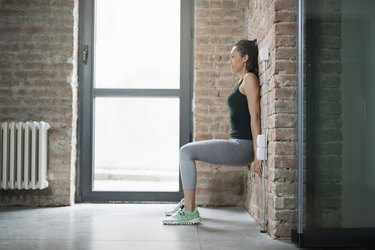
The following exercises to help knock knees will help strengthen the muscles that support your legs while improving flexibility and function. Their role is to address the knock knees muscle imbalance that can lead to ankle and back pain.
What Causes Knock Knees?
Video of the Day
Knock knees, also known by the technical name of genu valgum, is when the knees touch or angle inward, while the ankles do not touch and angle outward. Many toddlers have this condition, but it often corrects itself by the time they reach adolescence, states the Pediatric Orthopaedic Society of North America (POSNA).
Video of the Day
Individuals with genu valgum have a more inward twist of their thigh bone (femur) and an outward twist of the shin bone (tibia), which gives the appearance of knock knees. This condition can be caused by an injury to the growth plate, or it can be a developmental issue.
Although knock knees occur often in toddlers, if it appears later in childhood, it could be a sign of rickets or osteomalacia. Also, note that children who have overweight or obesity are more likely to develop genu valgum or knock knees, as well as flat feet. The best thing you can do as a parent is to see a doctor for a thorough evaluation.
Read more: How to Run With Flat Feet
Treatment Options for Knock Knees
Young kids with knock knees usually don't require bracing, surgery or physical therapy as this condition often resolves on its own, says POSNA. For older kids and adults, it's important to talk with a doctor who can determine the best course of action.
Knock knees may cause muscle imbalances and knee pain because the kneecap or patella is not tracking correctly, says the Hospital for Special Surgery (HSS). It may also lead to ankle, hip and back pain due to alignment issues of the knee and ankle.
In some cases, knock knee surgery for adults is indicated to relieve the pain. HSS reports that young adults may require an osteotomy surgery to correct the alignment, while older adults may need knee replacement surgery.
Lifestyle changes, such as losing weight, may help reduce stress on the knees. To stay safe, avoid high-impact activities like running or jumping. With knock knee braces, adults and children may experience a reduction in pain.
Although exercise alone can't correct the angle of your bones, it may relieve your symptoms. Knock knees create muscle imbalances that can be corrected with specific exercises, notes the University of California San Francisco (UCSF),
Read more: Bad Knees? Try These Strengthening Exercises
Exercises to Help Knock Knees
To help fix the knock knees muscle imbalance, it's important to strengthen the gluteal and quad muscles and stretch your IT band. These exercises can all help your patella move in a more normal pattern, says Kaiser Permanente.
Perform the following exercises to help knock knees twice a day. If any exercise increases your pain, stop and talk to your doctor.
Move 1: Bridges
- Lie on your back with your knees bent.
- Lift your hips off of the floor about 3 to 5 inches. Avoid arching your back.
- Hold for five to 10 seconds while squeezing your buttock muscles.
- Repeat 20 to 30 times.
Move 2: Clamshells
- Lie on your side with your knees bent and in front of you.
- Open your top knee up while keeping your feet together, like opening a clamshell.
- Tighten your buttocks as you lift your left up, keeping your ankles together.
- Hold for five seconds.
- Repeat 20 to 30 times.
Move 3: Wall Squat
- Stand with your back against a wall, with your feet shoulder-width apart and your feet 12 inches from the wall.
- Perform a squat, ensuring your knees stay over your ankles.
- Hold for five to 10 seconds.
- Repeat 10 to 20 times.
Move 4: IT Band Stretch
- Hold onto a wall or chair on the side you want to stretch.
- Stand with the leg to be stretched crossed behind the other.
- Lean your hips toward the chair or wall until you feel the stretch down the side of your leg.
- Hold 30 to 60 seconds.
- Repeat three to four times per day.
Since those with knock knees also often have flat arches, make sure you wear supportive shoes with arch support. You may also try the following exercise recommended by UCSF to help strengthen your arches.
Move 5: Toe Towel Scrunching
- Sitting down, place a towel under your bare feet.
- Scrunch a towel with your toes 15 to 20 times on each foot.
- Repeat two to three times a day.
- Pediatric Orthopaedic Society of North America: "Bowed Legs and Knock Knees"
- Pediatric Physical Therapy: "Genu Valgum and Flat Feet in Children With Healthy and Excessive Body Weight"
- Hospital for Special Surgery: "Ask the Expert: Dr. Austin Fragomen, Orthopedic Surgeon, Answers Your Questions on Knock Knees"
- University of California San Francisco: "Knock Knees"
- Kaiser Permanente: "Patella-Femoral Syndrome"